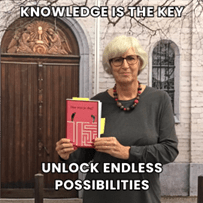“Let fear be a counselor and not a jailer.” – Anthony Robbins
The knot in your stomach, the clammy sweat, the feeling that you might throw up... What are you afraid of? And what if that fear is holding you back from doing what you really want to do? Unfortunately, I speak from experience. For years, I was afraid to pursue my dreams because I thought I wasn't 'good enough' yet. As a result, I stayed stuck in preparation mode and didn't dare to go for it. Now, with my third book published, I look back in amazement and realize how simple it actually was to overcome my fears. You just need to remember how you were as a baby. I'd like to share some tips with you.
1. Channel Your Inner Baby
Remember how you took your first steps as a baby. Were you afraid of falling then? Did you tell yourself that you could never do it? No, you just kept falling and getting back up until you could do it. Use that determination as inspiration to overcome your fears.
Tip: Take small, manageable steps towards your goal. Every small step forward is a victory, even if you sometimes fall.
2. Follow an Example
Babies always have an example of how to do something and have a sort of radar to mimic it. You can do the same by visualizing yourself doing it wonderfully. Try to see, feel, and smell it with all your senses. Your brain doesn't know the difference between imagination and reality, and this will activate certain neural pathways that help you face your fears. It might sound strange, but it really helps.
Tip: Visualize your success and imagine how you achieve your goal. Use all your senses to make the experience real.
3. Change Your Posture
By adopting the right posture, you'll start to feel different too. When someone feels bad, they slump their shoulders. But it works the other way around too; just by straightening your back, you'll start to feel better. Stand up straight, take a deep breath, and smile. This sends positive signals to your brain and can reduce your fear.
Tip: Use a powerful body posture to boost your self-confidence. Try the 'power pose' and notice the difference.
4. Just Start
A baby doesn't start with a detailed action plan in mind; they just go for it and learn what works through trial and error. Along the way, they will often fall, but each fall is an indication to adjust their method. This doesn't mean you shouldn't prepare; you can research how to approach something, but don't get stuck in preparation.
Tip: Just begin. Take that first step, no matter how small, and learn from your experiences.
5. Seek Support
The encouragement of friends and family is crucial. They help you celebrate your victories. Have you ever seen a mother tell her child, 'What a loser you are, trying to walk for the third time and still failing'? No, every small step is celebrated enthusiastically. Gather your personal cheerleaders: friends, family, colleagues—everyone who can encourage and inspire you. Even your neighbor with his dog can give you that extra boost of confidence.
Tip: Ask for support from your personal cheerleaders. Their encouragement can give you that extra push you need.
6. Celebrate Your Successes
This tip builds on the previous one. Make sure to celebrate every small step in the right direction, no matter how insignificant it may seem. We sometimes have the tendency to compare our steps to the final result and see how we fall short. A baby doesn't do that; they are happy with every extra step. By celebrating your success, you boost your self-confidence and create new neural pathways to success.
Tip: Celebrate every small victory. It helps you stay motivated and builds your self-confidence.
7. Use Positive Self-Talk
Think about how you would talk to a baby learning to walk. Talk to yourself in the same way: you are 'amazing' and you can do it. Think about the small and large achievements you've already accomplished in your life; this will help you realize how amazing you are, how amazing we all are. Keep doing this until you firmly believe it.
Tip: Talk positively to yourself. Repeat affirmations like "I can do this" and "I am strong."
In Conclusion
Fear can often hold us back from doing what we really want. But with these seven tips, you can overcome your fears and take action. Remember, it's not about eliminating fear entirely but working through it and coming out stronger on the other side. So next time you're faced with something you're afraid of, laugh at it, use these tips, and go for it!
What are your experiences with overcoming fear? Share your stories and tips in the comments below!
#OvercomeYourFear #PersonalGrowth #Motivation #ConquerFear #ButterflyEffects


























